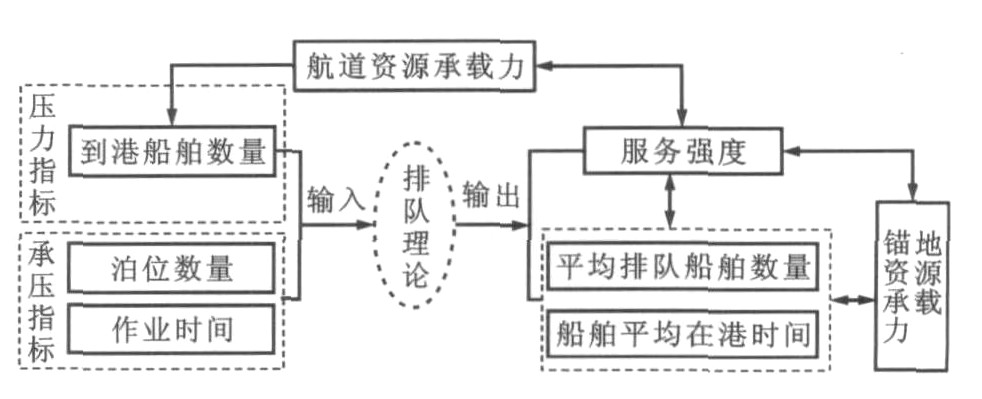Forecasting and early-warning model of port traffic resource carrying capacity
-
摘要: 根据航道交通容量计算方法, 建立了航道资源静态承载力模型, 基于锚地规模计算方法和基准判定参数, 建立了锚地资源承载力分级模型。应用排队理论, 将港口码头泊位的服务强度与航道资源、锚地资源的承载力模型相融合, 构建了港口交通资源承载力综合预测预警模型, 并以中国南方某港口进行实例验证。计算结果表明: 应用预测预警模型, 2008年与2010年的航道资源承载力指数分别为0.405与0.608, 锚地资源承载力综合指数分别为1.489与0.600, 2008年的港口码头服务强度为0.565, 计算结果与事实相符; 按照货物吞吐量的增长速度, 预计到2015年, 最小、最大航道资源承载力指数分别为0.593与0.796, 预计到2020年, 最小、最大航道资源承载力指数分别为0.685与0.944;基于现有锚地资源, 预计到2015年, 水深小于5m的最大锚地资源承载力指数为0.177, 水深在5~10m的最大锚地资源承载力指数为1.037, 水深大于10m的最大锚地资源承载力指数为1.294, 预计到2020年, 水深小于5m的最大锚地资源承载力指数为0.210, 水深在5~10m的最大锚地资源承载力指数为1.231, 水深大于10m的最大锚地资源承载力指数为1.535;预计到2015年, 港口码头的最小泊位服务强度为0.858, 预计到2020年, 港口码头的最小泊位服务强度为0.994。Abstract: Based on the calculation method of channel traffic capacity, the static carrying capacity model of channel resource was set up.According to the computing method of anchorage scale and basic judgment parameter, the classification model of anchorage resource carrying capacity was put forward.On the basis of queuing theory, the service strength of port berth and the carrying capacity models of channel resource and anchorage resource were fused, the comprehensive forecasting and early-warning model of port traffic resource carrying capacity was built, and example verification was carried out through case port in Southern China.Calculation result shows that by using the proposed model, channel resource carrying capacity indexes in 2008 and 2010 are 0.405 and 0.608 respectively, comprehensive anchorage resource carrying capacity indexes in 2008 and 2010 are 1.489 and 0.600 respectively, the service strength of port berth in 2008 is 0.565, and the calculation results are consistent with the fact.With the increase speed of cargo throughput, the minimum and maximum of channel resource carrying capacity indexes will be 0.593 and 0.796 respectively in 2015, and will be 0.685 and 0.944 respectively in 2020.Based on the existing anchorage resource, while water depth is below 5 m, the maximum anchorage resource carrying capacity indexes will be 0.177 and 0.210 respectively in 2015 and 2020.While water depth is from 5 m to 10 m, the maximum anchorage resource carrying capacity indexes will be 1.037 and 1.231 respectively in 2015 and 2020.While water depth is more than 10 m, the maximum anchorage resource carrying capacity indexes will be 1.294 and 1.535 respectively in 2015 and 2020.The minimum service strengths of port berths will be 0.858 and 0.994 respectively in 2015 and 2020.
-
表 1 航道资源承载力预警标准
Table 1. Early-warning standard of channel resource carrying capacity
指数范围 等级 承载状态 状态描述 Ih≤0.600 绿色 弱载 航道通行畅通, 服务水平很高 0.600 < Ih≤0.800 蓝色 适载 航道忙碌, 但通行畅通, 服务水平较高 0.800 < Ih≤0.900 黄色 高载 航道交通繁忙, 出现船舶等待进港现象, 服务水平较差 Ih > 0.900 红色 超载 航道严重拥堵, 造成船舶等待时间长, 服务水平极差 表 2 锚地资源承载力预警标准
Table 2. Early-warning standard of anchorage resource carrying capacity
指数范围 等级 承载状态 状态描述 Im≤0.750 绿色 弱载 锚地面积完全满足船舶的锚泊要求, 锚地富余面积大 0.750 < Im≤0.850 蓝色 适载 锚地面积满足锚泊船舶的需求, 有一定的锚地富余面积 0.850 < Im≤0.950 黄色 高载 锚地锚泊船舶密度大, 出现拥挤现象 Im > 0.950 红色 超载 锚泊船舶严重拥挤, 出现船舶无处锚泊现象 表 3 综合预警标准
Table 3. Comprehensive early-warning standard
指数范围 等级 承载状态 状态描述 ρ < 1.000且I≤0.750 绿色 弱载 排队等待船舶数量很少, 锚地面积完全满足船舶的锚泊要求, 锚地富余面积大 ρ < 1.000且0.750 < I≤0.850 蓝色 适载 排队等待船舶少, 锚地面积满足排队船舶的需求, 有一定的锚地富余面积 ρ < 1.000且0.850 < I≤0.950 黄色 高载 锚地锚泊排队等待船舶密度大, 出现拥挤现象 ρ≥1.000或I > 0.950 红色 超载 产生无限排队现象或排队等待船舶数量较大, 出现锚地面积不足与船舶无处锚泊现象 表 4 锚地资源承载力指数
Table 4. Anchorage resource carrying capacity indexes
年份 工况 T0/108 t Ij Im 水深小于5 m 水深5~10 m 水深大于10 m 2008 2.110 0.141 0.686 3.586 1.489 2010 2.800 0.139 0.647 0.793 0.600 2015 1 4.300 0.177 1.037 1.294 0.961 2 3.700 0.152 0.893 1.114 0.827 3 3.200 0.132 0.772 0.963 0.715 2020 1 5.100 0.210 1.231 1.535 1.140 2 4.400 0.181 1.062 1.324 0.984 3 3.700 0.152 0.893 1.113 0.827 表 5 码头泊位服务强度
Table 5. Service strengths of berths
年份 工况 T0/108t ρ M/艘 W/d I 2008 2.110 0.565 2015 1 4.300 > 1.000 2 3.700 0.994 155.000 1.012 0.899 3 3.200 0.858 0.867 0.007 2020 1 5.100 > 1.000 2 4.400 > 1.000 3 3.700 0.994 155.000 1.012 0.899 -
[1] 崔彭杰. 港口建设环境承载力评价指标体系及计算[D]. 杨凌: 西北农林科技大学, 2008.CUI Peng-jie. Evaluation index system and calculation of port construction environmental carrying capacity[D]. Yangling: Northwest A and F University, 2008. (in Chinese). [2] DUARTE P, MENESES M, HAWKINS A J S, et al. Mathematical modelling to assess the carrying capacity for multispecies culture within coastal waters[J]. Ecological Modelling, 2003, 168(1): 109-143. [3] ZHANG Ying-xuan, CHEN Min, ZHOU Wen-hua, et al. Evaluating Beijing's human carrying capacity from the perspective of water resource constraints[J]. Journal of Environmental Sciences, 2010, 22(8): 1297-1304. doi: 10.1016/S1001-0742(09)60253-9 [4] DANIEL A Z, ALLAN T, WILLIAMS A N. Recreation carrying capacity estimations to support beach management at Praia de Faro, Portugal[J]. Applied Geography, 2011, 31(3): 1075-1081. doi: 10.1016/j.apgeog.2011.01.020 [5] 周崇喜. 内河航道船舶通航能力研究[D]. 武汉: 武汉理工大学, 2006.ZHOU Chong-xi. The research of the interior water route's navigation ability[D]. Wuhan: Wuhan University of Technology, 2006. (in Chinese). [6] 罗松淼, 郑道昌, 刘桂云, 等. 虾峙门航道船舶通航能力评估[J]. 宁波大学学报: 理工版, 2007, 20(3): 410-413. https://www.cnki.com.cn/Article/CJFDTOTAL-NBDZ200703033.htmLUO Song-miao, ZHENG Dao-chang, LIU Gui-yun, et al. Estimation of navigation capacity for Xiashimen Channel[J]. Journal of Ningbo University: Natural Science and Engineering Edition, 2007, 20(3): 410-413. (in Chinese). https://www.cnki.com.cn/Article/CJFDTOTAL-NBDZ200703033.htm [7] 李国帅. 虾峙门航道通航能力及饱和度的研究[D]. 大连: 大连海事大学, 2008.LI Guo-shuai. Study on the traffic ability and saturation of Xiashimen Channel[D]. Dalian: Dalian Maritime University, 2008. (in Chinese). [8] LAM J S L. Patterns of maritime supply chains: slot capacity analysis[J]. Journal of Transport Geography, 2011, 19(2): 366-374. doi: 10.1016/j.jtrangeo.2010.03.016 [9] 陈胜锉. 港口锚地合理配布和优化设计的研究[D]. 大连: 大连海事大学, 2007.CHEN Sheng-cuo. The research on the reasonable layout and optimal design of port anchorage[D]. Dalian: Dalian Maritime University, 2007. (in Chinese). [10] 邢政. 秀山东锚地容量及安全性研究[D]. 大连: 大连海事大学, 2011.XING Zheng. Safty assessment study on Xiushan east anchorage waters of navigation environment[D]. Dalian: Dalian Maritime University, 2011. (in Chinese). [11] 邵俊岗, 许小兵, 王煜, 等. 洋山港区运营阶段的港口通过能力[J]. 上海海事大学学报, 2008, 29(4): 25-28. https://www.cnki.com.cn/Article/CJFDTOTAL-SHHY200804007.htmSHAO Jun-gang, XU Xiao-bing, WANG Yu, et al. Han-dling capacity of operation phase in Yangshan Port Area[J]. Journal of Shanghai Maritime University, 2008, 29(4): 25-28. (in Chinese). https://www.cnki.com.cn/Article/CJFDTOTAL-SHHY200804007.htm [12] 马勇. 基于排队论的T型航路船舶交通通过能力研究[D]. 大连: 大连海事大学, 2008.MA Yong. Research on vessel traffic pass through capacity of T-type channel based on queuing theory[D]. Dalian: Dalian Maritime University, 2008. (in Chinese). [13] 刘敬贤, 韩晓宝, 易湘平. 基于排队论的受限航道通过能力计算[J]. 中国航海, 2008, 31(3): 261-268. https://www.cnki.com.cn/Article/CJFDTOTAL-ZGHH200803014.htmLIU Jing-xian, HAN Xiao-bao, YI Xiang-ping. Capacity analysis of restricted channels based on the queuing theory[J]. Navigation of China, 2008, 31(3): 261-268. (in Chinese). https://www.cnki.com.cn/Article/CJFDTOTAL-ZGHH200803014.htm [14] SHABAYEK A A, YEUNG W W. A simulation model for the Kwai Chung container terminals in Hong Kong[J]. Euro-pean Journal of Operational Research, 2002, 140(1): 1-11. doi: 10.1016/S0377-2217(01)00216-8 [15] 刘敬贤, 李昌伟, 刘文. 基于排队论的锚地规模论证分析[J]. 船海工程, 2009, 38(4): 158-161. https://www.cnki.com.cn/Article/CJFDTOTAL-WHZC200904042.htmLIU Jing-xian, LI Chang-wei, LIU Wen. Anchoring zone scale analyzes based on the queuing theory[J]. Ship andOcean Engineering, 2009, 38(4): 158-161. (in Chinese). https://www.cnki.com.cn/Article/CJFDTOTAL-WHZC200904042.htm [16] SINGER M, DONOSO P. Assessing an ambulance service with queuing theory[J]. Computers amd Operations Research, 2008, 35(8): 2549-2560. [17] 赵景丽. 基于排队论的沿海港口航道通过能力及服务水平研究[D]. 青岛: 中国海洋大学, 2010.ZHAO Jing-li. Research on channel transit capacity and serv-ice level of sea port based on queuing theory[D]. Qingdao: Ocean University of China, 2010. (in Chinese). [18] 计明军, 陈哲, 王清斌. 集装箱船舶支线运输航线优化算法[J]. 交通运输工程学报, 2011, 11(4): 68-75. http://transport.chd.edu.cn/article/id/201104011JI Ming-jun, CHEN Zhe, WANG Qing-bin. Optimization algorithm of branch transportation route for container ship[J]. Journal of Traffic and Transportation Engineering, 2011, 11(4): 68-75. (in Chinese). http://transport.chd.edu.cn/article/id/201104011 [19] 郑士源. 干散货运输船舶投资订购的内在影响机制[J]. 交通运输工程学报, 2012, 12(1): 87-94. http://transport.chd.edu.cn/article/id/201201014ZHENG Shi-yuan. Intrinsic influence machanisms of dry bulk ship investment and ordering[J]. Journal of Traffic and Transportation Engineering, 2012, 12(1): 87-94. (in Chinese). http://transport.chd.edu.cn/article/id/201201014 -





 下载:
下载:








